FDA ISSUES DRAFT GUIDANCE ON REDUCING ACRYLAMIDE IN FOODS
Posted in News, Science & Research, Regulatory, Federal Register, Acrylamide, Chemicals, Cancer,Heating / Cooking, Fried Foods, Meat Products, Bakery / Cereal, Bread, Coffee, Cookies, Grains / Pasta / Tuber, Tuber, Potato, Immunity, Immune Health, Foodservice, Bakery, Breakfast Cereal, Food Safety
WASHINGTON—The U.S. Food and Drug Administration (FDA) today issued draft guidance for the food industry to help growers, manufacturers and food service operators take steps to reduce levels of acrylamide in certain foods.
Efforts to reduce acrylamide levels are already underway in many sectors throughout the food industry. In issuing the draft guidance, FDA seeks to support industry sectors that have taken a wait-and-see approach, and to help all companies—particularly smaller ones with fewer resources—reduce acrylamide in products susceptible to its formation.
Acrylamide is a chemical that can form in some foods during certain types of high-temperature cooking, such as frying, roasting and baking. Acrylamide in food is a concern because the National Toxicology Program (an interagency program that evaluates possible health risks associated with exposure to certain chemicals) characterizes the substance as “reasonably anticipated to be a human carcinogen."
To help mitigate potential human health risks, FDA’s draft guidance recommends that companies be aware of the levels of acrylamide in the foods they produce and consider adopting approaches, if feasible, that reduce acrylamide in their products. The draft guidance also offers a range of possible approaches that growers, manufacturers and food service operators can take to help reduce acrylamide levels.
The draft guidance, which is non-binding, covers raw materials, processing practices, and ingredients affecting potato-based foods (such as french fries and potato chips), cereal-based foods (such as cookies, crackers, breakfast cereals and toasted bread) and coffee, each of which is a significant source of acrylamide exposure.
The draft guidance is part of a number of activities initiated by the FDA to study acrylamide in food and help manage potential risks to human health. For example, the FDA is planning to publish additional data on acrylamide levels in certain foods based on its recent data collection and analysis. A summary of the FDA’s acrylamide work is available in a Q&A2 on the agency’s website.
Because acrylamide is found primarily in potato-based foods, cereal-based foods and coffee, for consumers, FDA’s best advice to help limit a person’s acrylamide intake is to adopt a healthy eating plan, consistent with the Dietary Guidelines for Americans that emphasizes fruits, vegetables, whole grains, and fat-free or low-fat milk and milk products; includes lean meats, poultry, fish, beans, eggs, and nuts; and is low in saturated fats, trans fats, cholesterol, salt and added sugars.
Efforts to reduce acrylamide levels are already underway in many sectors throughout the food industry. In issuing the draft guidance, FDA seeks to support industry sectors that have taken a wait-and-see approach, and to help all companies—particularly smaller ones with fewer resources—reduce acrylamide in products susceptible to its formation.
Acrylamide is a chemical that can form in some foods during certain types of high-temperature cooking, such as frying, roasting and baking. Acrylamide in food is a concern because the National Toxicology Program (an interagency program that evaluates possible health risks associated with exposure to certain chemicals) characterizes the substance as “reasonably anticipated to be a human carcinogen."
To help mitigate potential human health risks, FDA’s draft guidance recommends that companies be aware of the levels of acrylamide in the foods they produce and consider adopting approaches, if feasible, that reduce acrylamide in their products. The draft guidance also offers a range of possible approaches that growers, manufacturers and food service operators can take to help reduce acrylamide levels.
The draft guidance, which is non-binding, covers raw materials, processing practices, and ingredients affecting potato-based foods (such as french fries and potato chips), cereal-based foods (such as cookies, crackers, breakfast cereals and toasted bread) and coffee, each of which is a significant source of acrylamide exposure.
The draft guidance is part of a number of activities initiated by the FDA to study acrylamide in food and help manage potential risks to human health. For example, the FDA is planning to publish additional data on acrylamide levels in certain foods based on its recent data collection and analysis. A summary of the FDA’s acrylamide work is available in a Q&A2 on the agency’s website.
Because acrylamide is found primarily in potato-based foods, cereal-based foods and coffee, for consumers, FDA’s best advice to help limit a person’s acrylamide intake is to adopt a healthy eating plan, consistent with the Dietary Guidelines for Americans that emphasizes fruits, vegetables, whole grains, and fat-free or low-fat milk and milk products; includes lean meats, poultry, fish, beans, eggs, and nuts; and is low in saturated fats, trans fats, cholesterol, salt and added sugars.
Check out my new e-book entitled: "Social Media Marketing in Agri-Foods: Endless Profit and Painless Gain"
The book is available on Amazon and Kindle for $4.99 USD. Visit amazon/Kindle to order now:
http://www.amazon.ca/Social-Media-Marketing-Agri-Foods-ebook/dp/B00C42OB3E/ref=sr_1_1?s=digital-text&ie=UTF8&qid=1364756966&sr=1-1
Thanks for taking the time


No comments:
Post a Comment